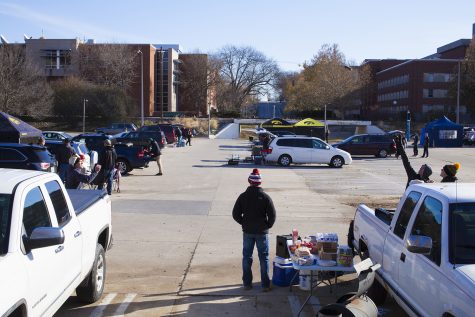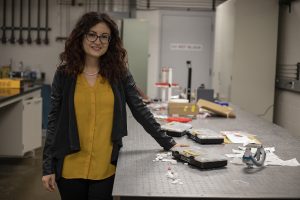Indian Creek Nature Center becomes only building in Iowa to receive renowned certification for sustainability
Cedar Rapids’ own Indian Creek Nature Center is one of 31 buildings in the world, and the only in Iowa, to receive the Living Building Challenge Petal certification for their Amazing Space. They received certification for the buildings sustainable focus and solar energy production.
Jenna Galligan/The Daily Iowan
Jean Wiedenheft explains net solar energy among some of the solar panels at the Indian Creek Nature Center in Cedar Rapids on Thursday, September 19, 2019. Jean explained that although the building does not run on solar power all day every day, “we give more to the grid than we take back from it.” The center recently received recognition as a Petal Certified Building under the Living Building Challenge.
September 26, 2019
The Indian Creek Nature Center is one of only 31 buildings in the world to achieve the Living Building Challenge Petal certification for its new “Amazing Space.” The center is the only building to receive this certification in Iowa, and it hopes to set the bar for sustainability across the state.
As the largest nonprofit nature center in Iowa, Indian Creek manages nearly 500 acres of land on various properties, said Jean Wiedenheft, the organization’s director of land stewardship. The center always focuses on providing a more sustainable future, she said, and this project shines a light on those efforts.
“Sustainability has always been one of our core values,” Wiedenheft said. “So, it [follows] that anything we would do in terms of building a new building would also fall in line with sustainable practices.”
To qualify for the Living Building Challenge Petal certification, the “Amazing Space” must produce more resources than it uses. Wiedenheft said the center worked with a number of design engineers to utilize solar power and meet the standards of the certification.
The all-consuming design for the “Amazing Space” project began in 2013 and took thousands of hours, Wiedenheft said. Making sure that contractors and subcontractors understood the center’s sustainable goals was challenging but worth it, she added.
“We just needed to make sure that everybody involved in the project was bringing us products that met our sustainable goal,” she said.
Solum Lang Architects, Ryan Companies, Rinder Rinderknecht Associates, and many union members constructed the building, according to the “Amazing Space” news release.
The release added that “more than 400 individuals, businesses and foundations invested $7.6 million in the ‘Amazing Space’ campaign.”
In addition, the Indian Creek Nature Center needed to pass an audit after at least a year of open doors to certify. Because of water-meter failure, however, the audit took place after even more than a year, Wiedenheft said.
“It took us longer to fine tune things to make sure things were working smoothly,” she said.
Ultimately, the center did pass the audit and successfully earned the Living Building Challenge Petal certification. Wiedenheft said the sustainable success of the organization is a result of the staff’s commitment to keeping its energy footprint light, she said.
The Indian Creek Nature Center’s Marketing Manager Elizabeth Zabel said that staff play a key role in the success of the “Amazing Space.” Through its sustainable commitment and enthusiasm, the center also makes an impact on the community, she said.
“A big part of what the staff does is just share the excitement of being a living building through tours and doing things that they especially feel inspired by with people who come to the building,” Zabel said.
The “Amazing Space” and its achievements in sustainability represent what’s at the heart of the center, Wiedenheft said. The goal is to create community awareness and promote environmentally conscious practices by individuals in their daily lives, she said.
Wiedenheft said the space is primarily for the community, and it is exciting to see awareness for sustainability grow. Zabel agreed, saying that the honor of receiving the Living Building Challenge Petal certification is really exciting for the community and puts Iowa sustainability on the map.
“It makes us a leader, obviously, it puts us on the global stage … to be one of 31 buildings to achieve this — that’s obviously a big deal,” Zabel said.





















